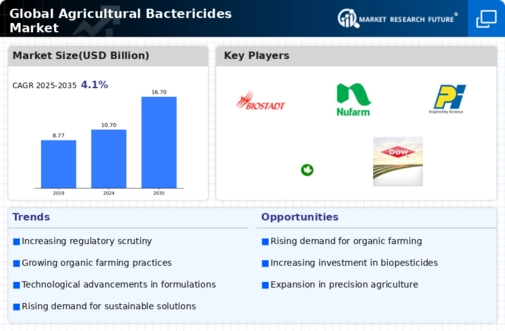Agriculture Bactericides Market Summary
As per Market Research Future Analysis, the Global Agricultural Bactericides Market was valued at USD 10.72 billion in 2024 and is projected to grow from USD 11.16 billion in 2025 to USD 16.68 billion by 2035, with a CAGR of 4.1% during the forecast period. Key drivers include the rising demand for improved crop yields and nutritional value, alongside increased health awareness. The market is influenced by the growing need for food security, regulatory interventions, and advancements in farming techniques. The copper-based bactericides segment held a significant market share of approximately 35-40% in 2022, while the liquid form is expected to dominate and grow faster due to ease of application. The Asia-Pacific region accounted for USD 10.72 billion in 2024, with significant growth anticipated due to rising agricultural activities.
Key Market Trends & Highlights
Key trends driving the Agricultural Bactericides Market include advancements in product formulations and increasing demand for quality crops.
- Market Size in 2024: USD 10.72 billion
- Projected Market Size by 2035: USD 16.68 billion
- CAGR from 2025 to 2035: 4.10%
- Copper-based bactericides contributed ~35-40% of market revenue in 2022
Market Size & Forecast
| 2024 Market Size | USD 10.72 billion |
| 2035 Market Size | USD 16.68 billion |
| CAGR (2025-2035) | 4.10% |
Major Players
Major players include G.M. Biocides Private Limited, FMC Corporation, Biostadt India Limited, Syngenta AG, BASF SE, and Bayer CropScience AG.
















